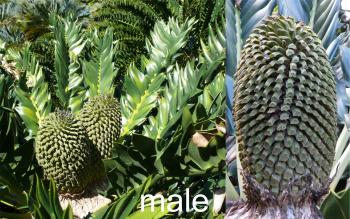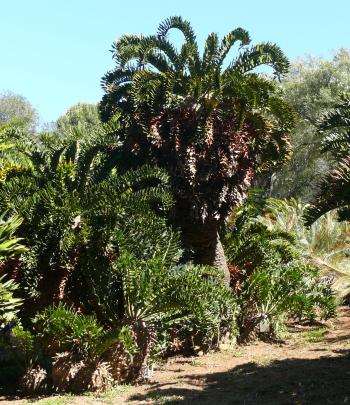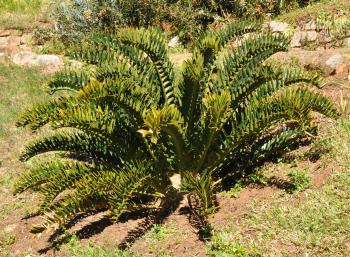Encephalartos latifrons
Encephalartos latifrons Lehm.
Family: Zamiaceae
Common names: Albany cycad (Eng.), Albany-broodboom (Afr.)
SA Tree No: 7
Introduction
Encephalartos latifrons is extremely rare and virtually extinct in its natural habitat. It is very attractive with the broadest leaves of all the cycad species.

Description
Description
Encephalartos latifrons develops stems up to 3 m in height and 300-450 mm in diameter. Stems can be single but are usually branched at the base, developing a number of stems as well as suckers. Mature leaves are glossy, dark green, hard and rigid. Young leaves are covered with fine hairs that disappear with age. A striking feature of E. latifrons is the 'skirt' of the brown, dead leaves which form a very distinct appearance at the base of the dark green leaves. The leaf stalk is 1 to 1.5 m in length with the top half curved or entirely curled back.

Encephalartos is a dioecious plant which means that the male and female elements occur on different plants. One to three olive green cones can be produced. The cones are borne on short, stout stalks. The male cone is cylindrical in shape and the female cone is barrel-shaped. The seeds are red. E. latifrons produces cones in midsummer, and does not necessarily cone every year. Plants in the living collection of E. latifrons at Kirstenbosch Botanic Garden have over the last 25 years produced between one and seven conings per plant and between 8-14 flushes of new leaves, which illustrates how slowly this species grows.

Conservation Status
Status
According to the website http://redlist.sanbi.org checked on 4 January 2016 the conservation status of this plant is Critically Endangered (CR). This species is in a critical state of continuing decline and has no natural seed set. The wild population has declined by more than 80% over the past 100 years, or three generations. It is an extremely fragmented population that occurs over a 9 km2 area with most individuals separated from each other by more than 1 km. All subpopulations consist of less than 20 plants. There are estimated to be between 60 and 100 wild individuals remaining. The pollinator is presumed extinct as there are too few plants to support them and there appears to have been no natural seed set or successful seedlings for more than 50 years.
The land on which Encephalartos latifrons occurs is used for crop cultivation and stock farming. Reports by Pearson and Chamberlain in 1919 imply that some of its habitat was lost to farming practices. Repeat photography using photographs taken between 1906 and 1945 show that most of the plants had disappeared by 1996, however this is not due to land use but due to the removal of plants to be sold as garden ornamentals. Trade in cycads is thus the greatest threat to this species and demand remains high because it is regarded as scarce.
Encephalartos latifrons is protected by both national and international legislation.
On a national level, i.e. within the borders of South Africa, the legislation differs from province to province and is policed by the province’s nature conservation authority. In the Western Cape, CapeNature is the regulatory authority and all Encephalartos species are listed as Endangered Flora and a permit is required to move, sell, buy, donate, receive, cultivate and sell Endangered Flora and to own adult Encephalartos plants.
On an international level, i.e. moving cycads over an international border, all species and hybrids of Encephalartos are listed on Appendix 1 of CITES (the Convention on International Trade in Endangered Species of Wild Fauna and Flora). This means that wild collected material may not be traded and for each and every artificially cultivated Encephalartos plant or piece of a plant or a cone or pollen or seed, being carried over an international border requires a CITES Export Permit issued by the authority of the exporting country, and a CITES Import Permit issued by the authority of the importing country.
Buyers are advised to make sure that the seller is a reputable, registered dealer and that an invoice is issued with the sale.
Distribution and habitat
Distribution description
Encephalartos latifrons occurs in scattered groups in the Eastern Cape Province. The plants occur on rocky outcrops and hills amongst scrub vegetation. No frost is experienced in their natural habitat. Summers are hot and fairly dry.

Derivation of name and historical aspects
History
This species was described in 1837–1838 by Lehmann. The specific name latifrons means 'broad-fronded' and refers to the leaves and their width.
Encephalartos latifrons is one of the rarest cycads and has probably never been abundant in the last 150 years. In 1916, Prof. H.H.W. Pearson, the first director of Kirstenbosch National Botanic Garden, wrote: 'This species appears to be on the verge of extinction. It is only known to occur in two localities, in which the plants are now very hard to find'. Scattered plants do occur in the habitat but male and female plants are so far apart that seed production is non-existent.
Prof. Pearson collected 19 plants and donated them to Kirstenbosch in 1913. Kirstenbosch has the largest ex situ living plants collection of E. latifrons and thus this species is the flagship of the Kirstenbosch Cycad Living Plants Collection, which currently consists of 32 adult plants. According to a DNA molecular study by da Silva et al. in 2012, the collection is important in that it has genotypes that are no longer present in the wild, which means that it can make a unique contribution to the gene pool. Furthermore, the IUCN red lists E. latifrons as Critically Endangered, with less than 100 plants known in the wild that have no natural seed set and no recruitment of seedlings. Therefore, the Kirstenbosch E. latifrons collection is important for conservation of the species.

Ecology
Ecology
Little is known about the pollination of Encephalartos latifrons as it is so rare. However, it is presumed to have been insect pollinated, since nine out the ten cycad genera have been proven to be insect pollinated.
Uses
Use
Encephalartos latifrons develops into a fine specimen in 15 years from seed and is ideal as a container plant. Large plants with a 1 m stem and larger make fine specimens in the garden. The living collection of E. latifrons at Kirstenbosch National Botanic Garden fulfils a role of display and education and is used to promote the conservation of the species by producing seedlings and making them available to botanic gardens and cycad enthusiasts.
Encephalartos latifrons is the first South African cycad to have a species Biodiversity Management Plan for conservation purposes; as a result of this, all 12 species of Critically Endangered South African cycads now also have this Plan. Despite these conservation measures, the leading threat (80%) to cycad loss in the wild, is their removal.

Growing Encephalartos latifrons
Grow
Although Encephalartos latifrons is very slow growing, this species does well in cultivation provided that it is planted in well drained soil, enjoys full sun and a cool winter without frost; it does not do well in subtropical climates. In its natural habitat, E. latifrons is subject to hot, dry summers and cool, frost-free winters. The high humidity and warmer winters in subtropical regions are probably not suited to this species. High pressure irrigation systems, which produce a strong jet of water, are to be avoided as they are fatal for all species of cycad. The strong jet of water will destroy the leaves as well as the stem of the plant. Cycads require regular feeding to maintain a healthy plant. A 50 mm thick mulch of well-matured compost applied in the autumn helps to improve the soil and benefits the cycads. In the early spring apply a mixture of bone meal, organic fertilizer and a balanced inorganic fertilizer to each plant.
Large specimens make excellent accent plants surrounded by lower growing species such as E. horridus, with the grey leaves contrasting well with the dark green leaves of E. latifrons. Young plants make ideal container plants. Good, sharp drainage is essential with regular watering plus annual feeding which will keep the plant healthy.
Scale and mealybugs, which are found on the underside of the leaves, could be a problem. Spray with a systemic insecticide. Mature plants when coning could attract snout beetles which destroy the seed. A contact insecticide needs to be applied to eliminate them. As new leaves appear they can be damaged by a tiny mite. A contact insecticide needs to be applied regularly every two weeks when the new leaves start appearing.
Encephalartos latifrons has been cultivated at Kirstenbosch since 1913 and propagation by seed has been poor, with below 10% germination. Recently (2014), the Kirstenbosch research team has solved the low seed germination problem. Hand pollinating the female cone with pollen harvested from a male cone is necessary in ex situ collections for production of viable seed and prevention of hybridization. In the past, at Kirstenbosch, hand pollination was carried out using the wet hand pollination method. However, an M.Sc. research study showed that wet pollination negatively affects seed embryo development and subsequent seed germination, compared to dry pollination. The study recommends dry pollination in the afternoon period when pollination droplets are abundant. Furthermore, after natural cone disintegration, seeds should be dusted with powder fungicide and stored for 12 months in relatively dry conditions. The recommended protocol yields over 50% seed germination.
Stored seed can be sown in summer on a bed of clean sand which has bottom heat of between 25–28°C. Within five weeks, the seeds start germinating, first producing a radicle followed by the leaves. By the following spring the seedlings are large enough to be planted and into a 3 litre plastic sleeve. A well-drained growing medium is essential. Until established, the young seedling must be watered sparingly.
The other method of propagation is by removing well-developed suckers, a minimum of 250 mm in diameter, from the parent plant. Remove all the leaves before carefully pulling them away from the main stem. The sucker should be left to dry off the wound before planting in clean sand to encourage rooting. Once well rooted, the sucker can be planted out into the open ground.
References
- Daly, B. et al (eds). 2006. Albany Cycad (Encephalartos latifrons) Population and Habitat Viability Assessment Workshop Report. Conservation Breeding Specialist Group (SSC / IUCN) /CBSG Southern Africa. Endangered Wildlife Trust, Johannesburg.
- Da Silva, J.M., Donaldson, J.S., Reeves, G. & Hedderson, T.A. 2012. Population genetics and conservation of critically small cycad populations: a case study of the Albany cycad, Encephalartos latifrons (Lehmann). Biol J Linn Soc. 105: 293–308.
- Donaldson, J.S. 2009. Encephalartos latifrons Lehm. National Assessment: Red List of South African Plants version 2015.1. Accessed on 2016/01/04
- Donaldson, J. S. 2012. Encephalartos latifrons in: IUCN 2012. IUCN red list of threatened species. version 2012.2. [Online]. Available at: www.iucnredlist.org [Accessed 28 February 2013].
- Giddy, C. 1974. Cycads of South Africa. Struik, Cape Town.
- Goode, D. 1989. Cycads of Africa. Struik Winchester, Cape Town.
- Kemp, M. 1986. Encephalartos latifrons. Journal of the Cycad Society of Southern Africa 8:8-15.
Credits
John Winter
Kirstenbosch National Botanical Garden
March 2006
updated by Phakamani Xaba
Kirstenbosch National Botanical Garden
January 2016
Plant Attributes:
Plant Type: Tree
SA Distribution: Eastern Cape
Soil type: Loam
Flowering season:
PH: Neutral
Flower colour:
Aspect: Full Sun
Gardening skill: Challenging
Special Features:
Horticultural zones








Rate this article
Article well written and informative
Rate this plant
Is this an interesting plant?
Login to add your Comment
Back to topNot registered yet? Click here to register.